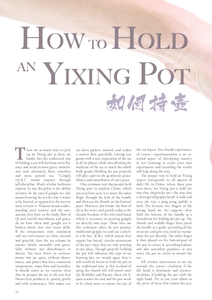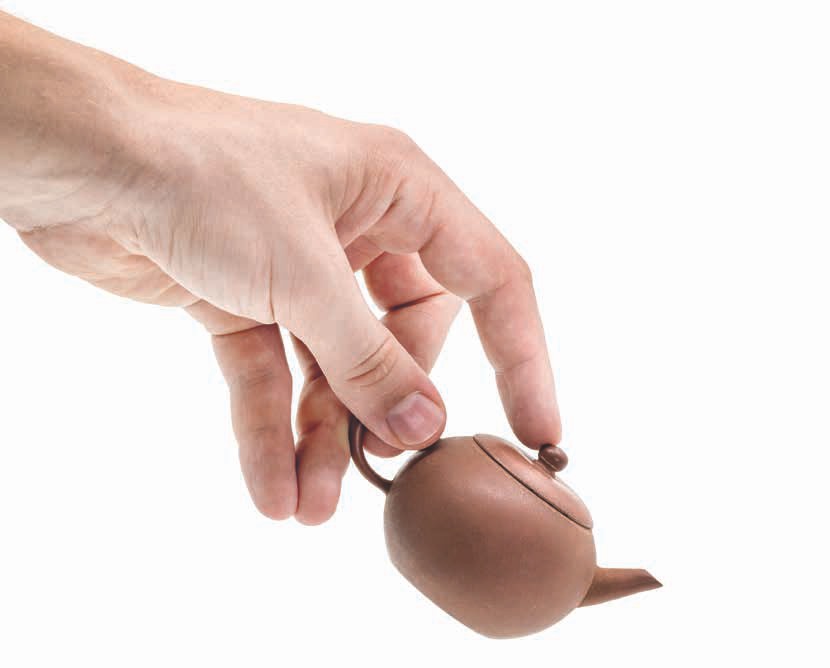
 |
|

There are as many ways to pick up an Yixing pot as there are hands, but the traditional way of holding a pot will facilitate more fluency, and result in more grace, smoothness and, ultimately, finer, smoother and more patient tea. "Gongfu (功夫)" means mastery through self-discipline. Much of what facilitates mastery in any discipline is the ability to listen. In the case of gongfu tea, this means brewing the tea the way it wants to be brewed, as opposed to the way we want to brew it. Mastery means understanding one's teaware and the connection they have to the body, flow of Qi and overall smoothness and grace. As we have often said, gongfu tea is broken down into two main skills: If the temperature stays consistent and our movements are slow, smooth and graceful, then the tea releases its essence slowly, smoothly and gracefully, without any disturbances or shocks. Tea trees thrive in environments that are quiet, without disturbance, and places that have consistent temperature, water flow and humidity. It should come as no surprise then that we prepare the tea in the way that Nature best produces it: quietly, gently and with consistency. This makes our tea more patient, smooth, and makes a session flow gracefully, leaving our guests with a nice impression of the tea in all its phases, while also allowing the medicine of the tea to reach the subtle body gently. Holding the pot properly will play a part in the gentleness, gracefulness and smoothness of one's pour.
One common way that people hold Yixing pots in modern China, which you may have seen, is to insert the index finger through the hole of the handle and then use the thumb on the button/ pearl. However, this breaks the flow of Qi at the wrist, and greatly reduces the circular freedom of the wrist and hand, which is necessary in pouring gongfu tea directly into cups. Those who use this technique often do not practice traditional gongfu tea and use a pitcher (cha hai, 茶海), which means they require less lateral, circular movement of the pot, since they are only pouring in one place. Though properly holding the pot will influence this type of tea brewing less, we would argue that it still would be better to hold the pot in the traditional way, as this method of using the thumb will still pinch one's Qi, flexibility and fluency when the liquor reaches the end and the pot needs to be tilted more to release the last of the tea liquor. You should experiment, of course - experimentation is an essential aspect of developing mastery in tea! Learning to create your own experiments and recording the results will help along the way.
The proper way to hold an Yixing teapot corresponds to all aspects of daily life in China, where these pots were born. An Yixing pot is held the way that chopsticks are - the way that a writing/calligraphy brush is held and even the way a ping pong paddle is held. The bottom two fingers of the strong hand are the support - they hold the bottom of the handle as a foundation for holding the pot up. The thumb and middle finger then pinch the handle as a guide, providing all the structure and give you need to manipulate the pot fluently. The index finger is then placed on the button/pearl of the pot to center it, providing balance and also secondary guidance as you move the pot in circles to decant the tea.
All circular movements in tea are towards the center - clockwise if the left hand is dominant and counterclockwise if holding the pot with the right hand. Try to use your elbow as the pivot of force that rotates the pot. This will create more balance, harmony and, in the end, a smoother pour. Upward and downward movements of the pot are like a phoenix - coming from the wrist and upper hand. We lift the pot from the palm and the two bottom fingers, which are the foundation. To drop, then, the phoenix dips down, with a force that comes from the elbow down and over the hand. This dipping and raising the pot with the elbow and hand will require some skill (gongfu) to master, but, as with all things, practice makes perfect.
Gongfu tea is all about mastery and control. Try not to just pick up or hold the pot, but connect with it. In other words, your sense of "self " doesn't need to end at the handle, which is then consciously or unconsciously felt to be "other" or just an "object." Instead, feel the pot as an extension of you. Making nice tea will incorporate the flow of energy (Qi) through the body, down the arm and through the pot. Furthermore, try not to dump the liquor out, but rather place it exactly where you wish, as it also is an extension of your energy.
The proper way to hold a pot does not end with the placement of the hand; it actually includes the whole body: our feet should be flat and firmly planted on the ground (or we are seated cross-legged on the ground); our arm should never pinch at the shoulder, which means our arm is lifted too high, clipping Qi (the same applies for the kettle); the circular movements we make should come from the elbow, gently pivoting the whole arm; finally, lifting and lowering the put should come from the opposite movement of the arm - dropping the arm lifts the pot, and vice versa.
Try holding your Yixing pot in different ways and pouring a round of cups. Try to feel how much smoother, more graceful and fluid the traditional method of holding the pot is. It is not by coincidence that all food was eaten with chopsticks held in this way, all writing and painting done with brushes held in this way. Even swords and many other weapons were used in this way. This method, like all things gongfu tea, was born out of martial arts, as an aspect of these masters' lifeways. These ancient aspects of Chinese culture were born of practice and harmony with these utensils, and therefore, shouldn't be taken for granted. Still, one should always understand all practical things in tea for oneself - experimenting and practicing until the reasons why things are done become clear in a very real, practical and physical way. Only then will you start developing gongfu. And that process of refinement won't ever end. We find ourselves improving our teapot control even decades later, and will continue to do so as long as we are alive to celebrate a tea practice!


